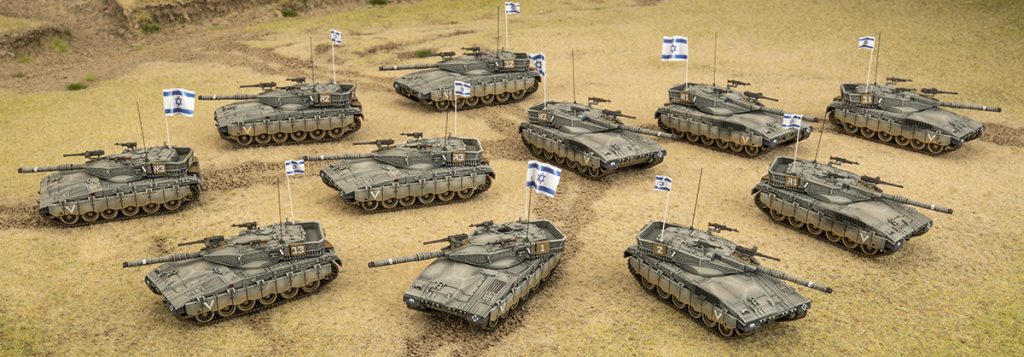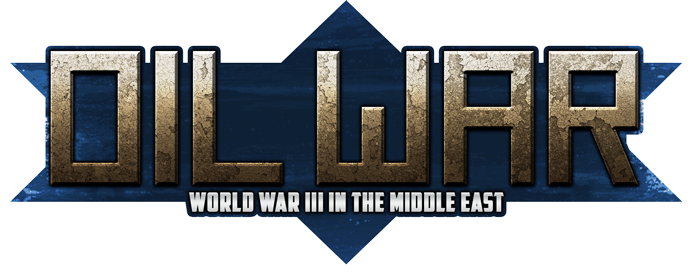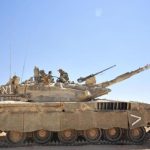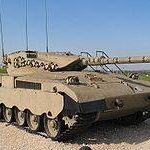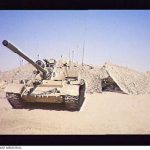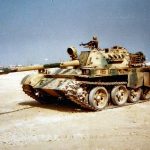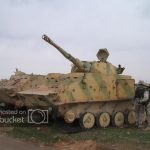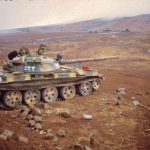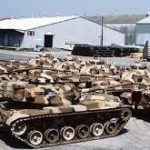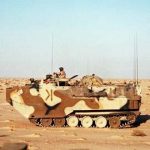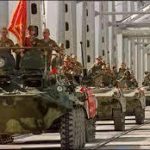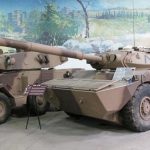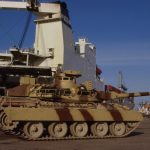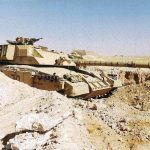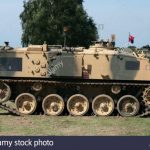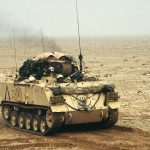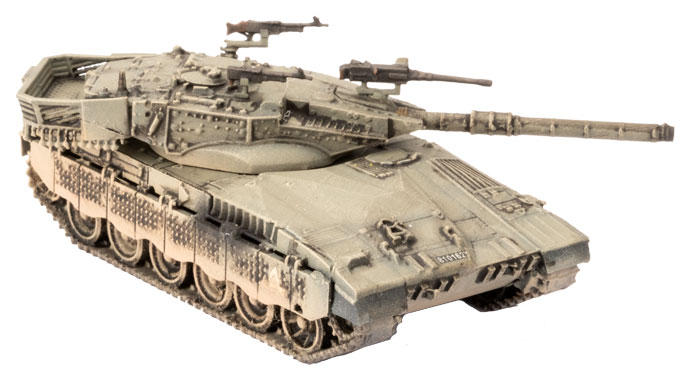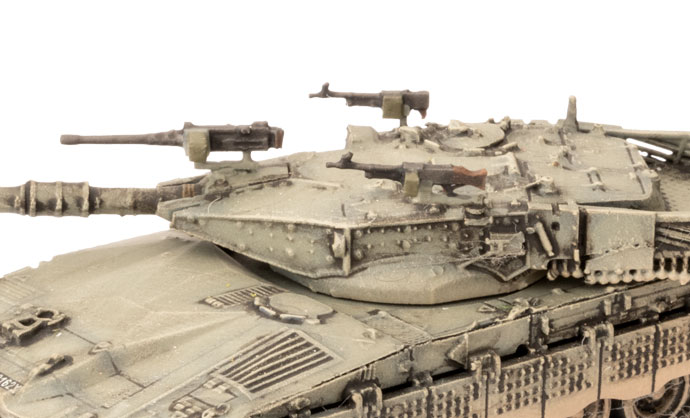Tag: Israel
Victor’s Merkava II Company
with Victor Pesch
When I first saw the prototypes of the Merkava model we were making, I knew I’d have to do an army. I was lucky enough to do the graphic design for the book so I became further interested in the Israeli forces. As soon as the plastics arrived in the office, I commandeered 11 of them and got to work.


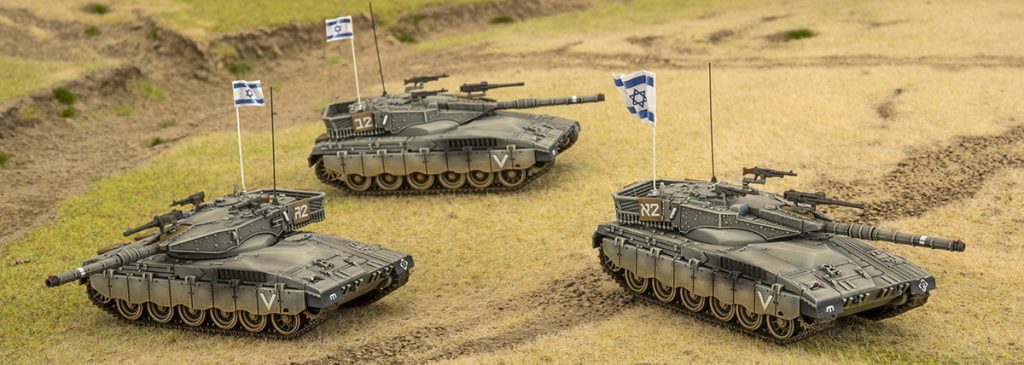
Painting Desert Camo
with Aaron Te-Hira Mathie
With the release of Oil War we at Battlefront are taking a trip back to the desert. In this book we seek to examine the first days of a major conflict between the two superpowers of the Cold War era spreading out to encompass Western Asia. As part of this enlarging of the conflict as we have envisioned it, we examine four armies, Israel, Iran, Iraq, and Syria.
The book sets down some organisational structures and basic philosophies of use that each of these armies employed based on their long or on-going experiences of fighting in this inhospitable environment. They determine everything from what equipment and tactics they use, to how they paint their military equipment.
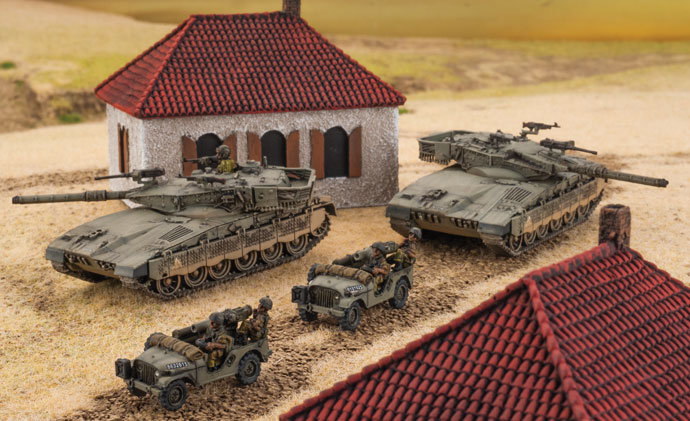
The battlefield of the 1980s is an interesting cross-section of emerging technologies that seek to make the three tasks above more simple, and older ideas and technologies that are more tried and tested.
Items like Thermal Imagers and Laser Rangefinders do indeed make the problems of spotting, identifying, and ranging potentially more simple, however at the time these pieces of technology were bulky, expensive, and difficult to maintain.
So while parts of an army might have access to some or all, the vast majority of troops still only have the Mk.1 eyeball, and this is where camouflage comes in.
So what is the basic purpose of camouflage?
Some of you already know, but some will not.
The answer is that camouflage, especially with regards to large pieces of equipment (for instance a Main Battle Tank), is used to fool the human brain into thinking that the object being viewed is not there, something else or at a different distance than it is.

These types of terrain features are not nearly as prevalent in a desert.
The terrain in desert environments is often marked by flat open areas providing little in the way of natural cover and concealment. Therefore the paint job on your Tank is fairly unlikely to fool anyone into thinking that it is a small hill or clump of trees as it might in Europe.
The only way that this is going to work in an arid desert environment is to bury the item in the sand, while this is a workable option for static defences it is not an ideal situation if mobile warfare is the name of the game.
The armies examined in Oil War approach the problem from two directions.
Israel and Iran choose to paint their ground based military equipment in a drab light green grey colour. The reason is that these armies are expecting to fight in varied terrain, from the desolate Negev desert to the more temperate Golan Heights and Southern Lebanon in the case of the IDF.
Therefore they have decided to go with a neutral colour that will not stick out in either type of environment when clean, and with local dust will do a good job of blending in, thus rendering the vehicle more difficult to detect.
Iran/Israeli Colours
This approach does a good job of concealing, therefore making the task of locating the target more of a challenge, however it does not address the problems of target identification and ranging to the same degree.
Iraq and Syria approach the issue by employing camouflage patterns.
These are more terrain specific and more time consuming to apply, but do break up the shape of the piece of equipment more effectively, therefore making accurate target identification and ranging more difficult, at the expense of being able to be used in multiple environments without being changed.
Iraqi Colours
Other armies briefly mentioned in the book generally approach the problem in much the same way.
Syrian Colours
So for instance, the US forces for the most part were deploying for Exercise BRIGHTSTAR in Egypt, therefore would for the most part be using the Grey Desert version of MERDC, which consists of a sand coloured base, overpainted with field drab, earth yellow and black.
US Colours
Whereas the Soviet forces are depicted as using their ubiquitous drab green.
However, this does not Have to be the case. Team Yankee takes place in an alternate reality, so you could paint your Soviet models in the green and beige camouflage pattern used by them during their military involvement in Afghanistan during the 1980s, equally US forces could be using the all over light sand colour as seen during the 1991 Gulf War, as could your Iraqi forces.
Soviet Colours
If you do choose to paint your forces in camouflage, it is a good idea to see if an existing template exists. If so, use that if historical accuracy is your jam.
French Colours
This also generally means that the hard work of figuring out colour placement and shape, in order to best break up the shape of the piece of equipment, has already been done.
British Colours
However, in the case of camouflage schemes that have been applied without a template (for instance Iraq or Syria), a good way to approach the situation, is to either find historical photographs to help give you a general look and feel, applying basic camouflage principles (for instance ensuring that no surface is entirely one colour) or a combination of both. In this way you will be able to ensure a more lifelike appearance to your miniatures.
Chris’ Israeli Merkava 2 Tank Company
with Chris Townley
It comes as no surprise to anyone that has followed our various Arab-Israeli releases over the years that I have strong interest in the fighting between the Israelis and their Arab neighbours over the course of the 20th century. The release of Oil War lets me take that interest over from Fate Of A Nation and bring it in to Team Yankee. I’m very excited!
Looking through the list I was of course hoping to leverage some of my previously painted models to build the basis for a new army, just like I am doing with my 1973 Syrians (more on this later). Of course, the major flaw in that plan was that whilst Magach 6 (M60 Patton) tanks are awesome, not only do I not have any painted for my ’73 force, they are just not as cool as the new Merkava tank! Possibly one of the best-looking armoured vehicles and certainly one of the most iconic!
To begin with, I decided to add a full-strength Company of these bad boys, choosing to use the Merkava 2 models with their improved armour stats (slightly more front armour, as well as improvements to the side and HEAT protection). Coming in at 7 points each of these, 11 models made for 77 points. That’s more than enough for a few toys!
If I was to say that there was a flaw to the Merkava tanks, it would be their 105mm gun – knowing that their main opponents would be older generation Soviet tanks (which the 105mm can deal with easily) the early models do not have the same hitting power as other Western tanks that have the nastier 120mm gun.
To balance this out I decided to add anti-tank missiles… lots of anti-tank missiles. A platoon of the top-secret Pereh tanks meant I got a super unique looking model, something that can hit anyone, anywhere, anytime, and an AT 21 missile.

I also added a platoon of Jeeps with TOW missiles – I love the Sayur Company (from Fate Of A Nation) and the thought of adding Jeeps zipping around the table really appeals to me. I also took the opportunity to add a Jeep Recce Platoon to my Merkava Formation for the same reason…
To round out the Force I chose to add a pair of M163 VADS for some AA protection, along with a pair of M48 Chaparral SAM launchers. This gives me some close in firepower that can be used to knock down close air support and choppers, or hordes of Syrian (or Soviet) infantry, along with the heavier Sidewinder missiles (on the M48) that can engage airborne targets anywhere on the tabletop. Being relatively small platoons means I will need to keep them behind the lines or risk losing them however…
My plan is fairly simple – hit hard, hit fast and hope that the armour of the tanks will see me through. None of my platoons are very big so I when I start suffering casualties, I will need to rely on the superior Morale of the army to keep my troops on the table, but I think I have a good combination of equipment to give me a fighting chance against most enemies.
Thinking about the long term I’d love to add a few more units to the army to give me some extra flexibility – a M113 Mech Infantry Platoon, AH-1 Viper Attack Helicopter Platoon (or two), Redeye SAM Platoon and aircraft will be high on my “to-do” list!
~Chris

